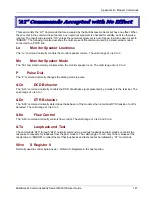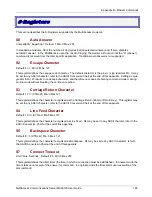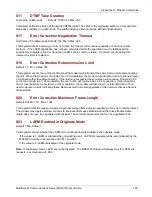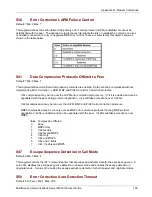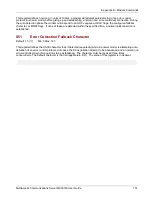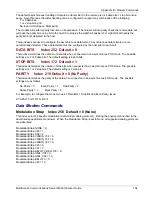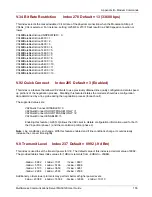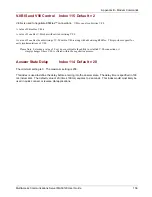
Appendix B – Modem Commands
MultiAccess Communications Server MA30120 User Guide 142
Parser Character Settings
Certain characters used by the “AT” command parser and response generator are settable if the provided
defaults are unsuitable. They can be changed via the appropriate S-register. The table below shows the
semantics of the settable characters, the S-registers that hold them and the default values:
Settable Characters
S-Register
Default Value (Symbol)
Escape character
S2
43 (+)
Line Feed
S3
13 (\r)
Carriage Return
S4
19 (\n)
Backspace S5
8
(\b)
Echo
By default, the “AT” command parser does not echo back command characters received from the host.
Command mode echo can be enabled with the “E
n
” command as described in the “AT” Commands Supported.
Numerical Arguments to Commands
Many commands take a numerical argument immediately after the command character. For example “E
n
”
accepts the numbers 0 and 1 for
n
. It is permissible to omit this argument, in which case the effect is the same
as if the argument 0 had been supplied. For example “E” has the same effect as “E0”.
Result Codes
The “AT” command parser maintains a “result code”, which is set to “OK” at the start of command input string
parsing. An invalid command in the input string causes the result code to be set to “ERROR”. The command
being parsed is not executed. Any characters in the command input string after the error is detected are not
parsed, so that any correctly constructed commands beyond the error are not executed. If no errors occur, the
result code remains “OK”. The result code is sent to the host when the parser terminates, either by reaching
the end of the command input string or by detecting an error. The format in which the result code is sent to the
host may be controlled as described in the “Qn”, “Vn”, and “\Vn” in the “AT” Commands Supported.
Three commands are exceptions to the sending of the “OK” or “ERROR” result code. These are “ATA”, “ATD”,
and “ATO”, refer to “AT” Commands Supported. Each of these commands itself terminates command input
string parsing. They cause the modem to perform an action which is then reported by specific result codes
such as “CONNECT”.
Null Command
The null command is permitted, has no effect and has an “OK” result code. A null command occurs when:
• the command input string consists only of the prefix “AT”
• the “A/” command is sent before any other command
Key-Press Abort
The key-press abort feature allows users to abort a call attempt after initiation, but before the link is established
simply by pressing a character key on their terminal. Key-press abort is enabled upon receipt of an “A”
(answer) or “D#” (dial) commands. Key-press abort is disabled when the modem reaches the Data state
or
enters the Terminating state having failed to establish the link. If any downstream data arrives at the modem
from the host while key-press abort is enabled, then the modem will terminate the link. In addition, the result
code “(ABORTED)” will be sent to the host prior to the usual “NO CARRIER” that occurs at link termination.
Escape Sequence Detection
When a modem is in the Data state (on-line\connected), downstream data (data transmitted from the host
application via telnet to the MultiAccess) is passed over the dial up link to the peer system. The “AT” command
processor may nevertheless still inspect this data looking for the “escape-to-command-mode” character
sequence. If the sequence is detected, the modem will transition to the Command Escape state. Further
downstream data will be directed to the “AT” command parser. Escape sequence detection consists of
examining data sent to the modem from the user‘s host application for the character specified in S2 (‘+’ by
default). Only if the buffer consists solely of one, two or three instances of this character does it contribute to
Summary of Contents for MultiAccess MULTIACCESS MA30120
Page 1: ...MA30120 User Guide ...




















